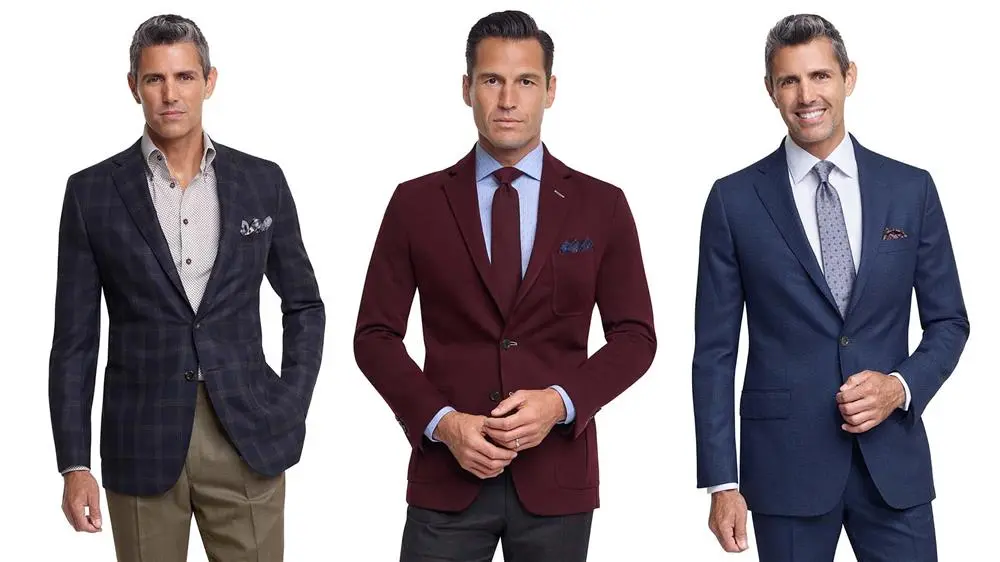In the world of men’s fashion, the terms sport jacket, blazer, and suit are often used interchangeably, but doing so can lead to confusion and, sometimes, style missteps. While they may look similar to the untrained eye, each of these jackets has its own unique purpose, level of formality, and styling rules.
Understanding the differences between them helps you dress appropriately for any occasion, express your personal style, and build a versatile wardrobe with confidence. In this guide, we’ll break down the key features that set them apart, when and how to wear each, and how to choose the right one for your lifestyle.
Let’s dive in by exploring what makes the sport jacket, blazer, and suit jacket each stand out.
The Sport Jacket (Sport Coat)
The sport jacket, also known as the sport coat, has its roots in the countryside, originally designed for outdoor activities like hunting and riding. Over time, it evolved into a stylish yet casual option for men who wanted to look put together without the stiffness of formalwear.
Fabric & Fit
One of the most distinctive features of the sport jacket is its fabric. It typically comes in textured, patterned materials such as tweed, houndstooth, or herringbone. These fabrics are not only visually interesting but also durable, making the jacket a functional choice for everyday wear.
The fit of a sport jacket is more relaxed compared to a blazer or suit jacket. This allows for layering—think sweaters or turtlenecks underneath, especially in colder seasons.
Styling
Sport jackets are incredibly versatile. You can pair them with jeans, chinos, or even corduroy trousers for a laid-back but polished look. Because they come in various patterns and colors, they offer more personality than the standard blazer or suit.
When it comes to a sport coat vs blazer, the sport coat tends to offer more relaxed styling options and rugged fabric textures. It’s the kind of jacket that says, “I care about how I look, but I’m not trying too hard.”
When to Wear
Sport jackets are best suited for smart-casual and business-casual settings. Think weekend brunches, casual office days, networking events, or date nights. They’re also great for those transitional seasons when you want a layer that looks sharp but feels comfortable.
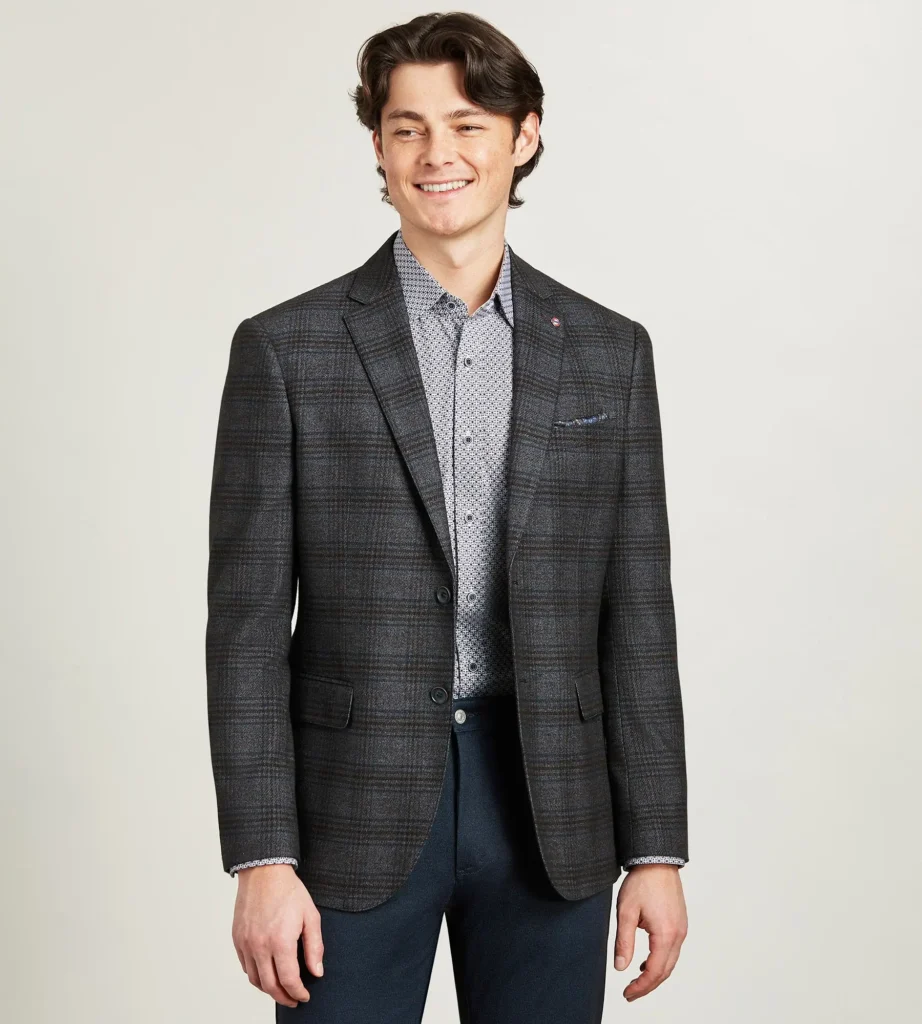
The Blazer
The blazer holds a special place in men’s wardrobes because of its balance between casual comfort and structured polish. It originated as part of naval and rowing club uniforms in the 19th century and has since become a smart choice for both social and professional settings.
Fabric & Features
Blazers are usually made from solid-colored fabrics, most commonly navy wool or cotton, and they often feature distinguishing elements like metal or brass buttons and structured shoulders. Unlike sport jackets, they are rarely patterned, although you may occasionally find subtle textures or weaves.
A defining detail of many classic blazers is the contrast in buttons, which adds a hint of heritage and character. The overall look is cleaner and more refined than the sport jacket, but still not as formal as a suit.
Styling
Blazers are incredibly adaptable. You can dress them up with dress trousers and a tie for a business meeting or tone them down with chinos and loafers for a dinner date. They work well in both day and evening settings, making them a true wardrobe workhorse.
Understanding the blazer vs sport coat comparison, the blazer leans more refined while still allowing for individual flair. It bridges the gap between the relaxed nature of a sport coat and the formality of a suit jacket.
When to Wear
Blazers shine in semi-formal to business-casual environments. They’re a go-to choice for job interviews, presentations, cocktail events, and even casual Fridays at the office. If you need a jacket that works across multiple dress codes, the blazer is your best bet.

The Suit Jacket
The suit jacket represents the highest level of formality among the three. It is designed as part of a complete set, jacket and trousers made from the same fabric and dyed in the same color. This coordination is what makes a suit stand out in both structure and purpose.
Structure & Style
A suit jacket is the most tailored option. It’s constructed with clean lines, sharp lapels, and a close-to-the-body fit that gives it a more polished appearance. You’ll often find it in solid colors like black, navy, or grey, as well as subtle patterns like pinstripes or checks.
It typically features finer construction details such as canvassed linings, hand-stitched lapels, and matching buttons. The level of detail speaks to its purpose: professional and formal occasions where every part of your outfit is expected to align.
Formality
This is where the suit jacket differs most significantly from the sport jacket and blazer. While the other two can be worn as separates, a suit jacket is never meant to be worn without its matching trousers. Pairing it with jeans or chinos is a fashion faux pas that breaks the integrity of the look.
In the suit jacket vs blazer conversation, the suit jacket always pairs with matching trousers, making it a more cohesive and polished outfit. It’s built for boardrooms, weddings, formal dinners, and any setting that calls for a complete, unified appearance.
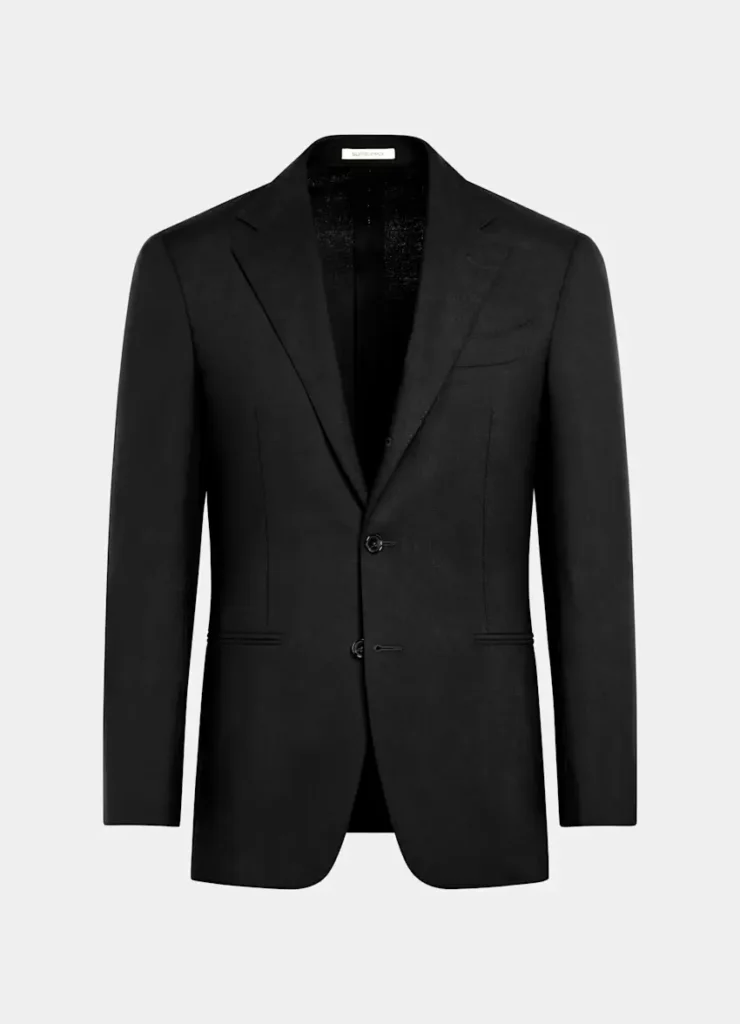
Key Differences at a Glance
While all three jackets, sport jacket, blazer, and suit, fall under the umbrella of tailored menswear, the distinctions between them are both functional and stylistic. Here’s a side-by-side comparison to help clarify their key differences:
1. Fabric and Patterns
- Sport Jacket: Textured and often patterned (e.g., tweed, plaid, herringbone)
- Blazer: Usually solid-colored with smoother textures (e.g., wool or cotton)
- Suit Jacket: Always matches trousers; fabrics are smoother, more refined, and consistent
2. Fit and Construction
- Sport Jacket: Looser fit for layering; less structured
- Blazer: More tailored than a sport jacket; moderately structured
- Suit Jacket: Most structured and tailored of the three
3. Button and Pocket Styles
- Sport Jacket: Patch pockets, elbow patches, and casual buttons
- Blazer: Often features gold or metal buttons, flap or patch pockets
- Suit Jacket: Flap or jetted pockets; buttons match the fabric for a clean look
4. Intended Occasions and Dress Codes
- Sport Jacket: Ideal for casual and smart-casual settings
- Blazer: Suitable for semi-formal and business-casual events
- Suit Jacket: Reserved for formal and professional occasions
This simple comparison helps reinforce how each jacket plays a distinct role in a well-rounded wardrobe.
Common Misconceptions Cleared
Despite their distinct qualities, sport jackets, blazers, and suit jackets are often confused for one another, especially by those just beginning to explore men’s fashion. Let’s clear up some of the most common mix-ups.
1. “A Jacket is Just a Jacket”
This is probably the most widespread misconception. Many assume that any structured, tailored jacket can be swapped in for another. But doing so can result in a mismatched or underdressed look. Each jacket has its own function, and ignoring those differences can send the wrong style message.
2. “I Can Wear a Suit Jacket Like a Blazer”
This is a tricky one. While it might seem harmless, using a suit jacket as a blazer, especially with jeans or chinos, can diminish the elegance of both pieces. Suit jackets are designed to be worn with their matching trousers. Wearing them as separates often looks off, because the fabric and cut aren’t made to stand alone.
3. “Blazer and Sport Jacket Mean the Same Thing”
Not quite. Many confuse the sports coat vs blazer simply because they’re both standalone jackets. But the details, fabric, structure, and styling set them apart. The sport coat is more relaxed and rugged, while the blazer is cleaner and more refined.
Understanding these subtle differences helps you avoid these styling mistakes and approach your wardrobe with greater confidence.
Style Guide: How to Choose the Right Jacket
Selecting the right jacket isn’t just about looking good—it’s about dressing with intention. By understanding the purpose of each piece and aligning it with your lifestyle and preferences, you can build a wardrobe that works smarter for you. Here’s how to choose wisely:
1. Consider the Occasion
Think about where you’re going.
- Sport jackets are great for informal gatherings, creative workplaces, or weekend outings.
- Blazers work well for business-casual settings, networking events, or smart dinners.
- Suit jackets are essential for weddings, interviews, corporate environments, and other formal events.
2. Think About Fabric and Season
- Heavier fabrics like tweed or flannel work well in cooler weather and are typical of sport jackets.
- Blazers in cotton or lightweight wool offer year-round flexibility.
- Suit jackets are usually made of fine wool blends ideal for temperate climates, though summer-weight and winter-weight options are available.
3. Match with What’s Already in Your Wardrobe
- If you wear jeans or chinos often, a sport jacket or blazer is a better match.
- If you frequently attend formal events, investing in a well-tailored suit or two is a must.
- Stick to versatile colors like navy, charcoal, and medium gray before experimenting with patterns.
4. Let Your Style Speak
Are you more traditional or trend-forward?
- A classic navy blazer with gold buttons leans timeless.
- A patterned sport jacket shows personality and ease.
- A slim-fit suit with sharp lapels projects precision and confidence.
When making style decisions, it’s helpful to know the difference between blazer and coat. The coat is typically worn over your jacket for warmth, while the blazer serves as the core element of your outfit. Knowing when to reach for which piece can elevate your entire appearance.
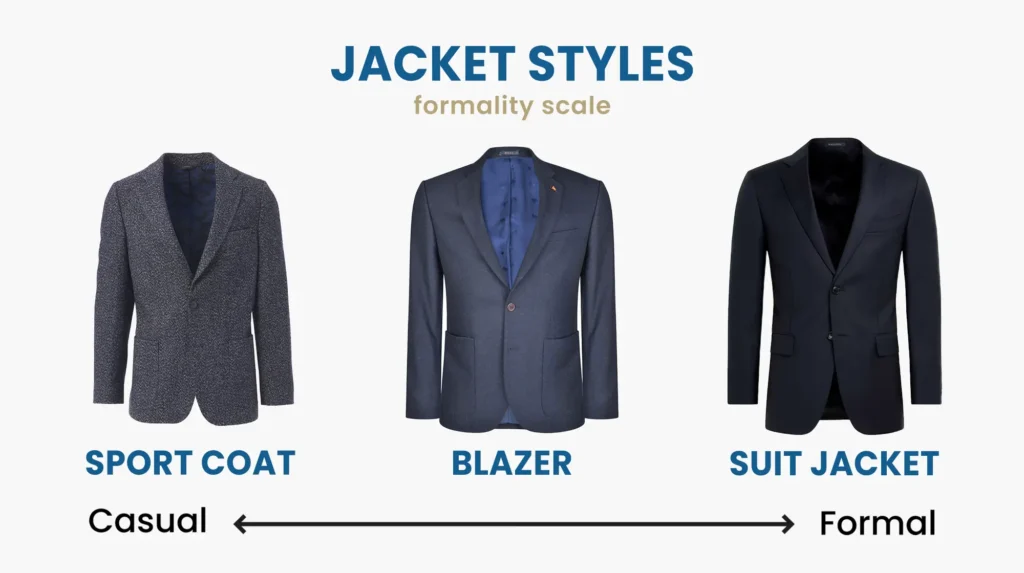
Understanding Fashion Terms
In the world of menswear, certain terms get tossed around a lot: blazer, coat, suit, jacket, and they can quickly blur together. Here’s a quick guide to help you make sense of them and use them confidently.
Blazer vs. Coat
The difference between blazer and coat lies in their function. A blazer is a tailored, mid-weight garment meant to be worn indoors or as part of an outfit, while a coat is an outerwear piece designed primarily for warmth and weather protection. You might wear a coat over a blazer, but never the other way around.
Coat vs. Blazer
Thinking about the difference between coat and blazer, coats are longer, heavier, and often made of wool or waterproof materials. Blazers, on the other hand, are typically cut to the hip, designed with structure, and styled for professional or semi-formal wear.
Suit vs. Blazer
A key difference between suit and blazer is coordination. A suit includes a matching set of jacket and trousers made from the same material, designed to be worn together. A blazer stands alone, offering flexibility and mixing potential with various bottoms.
Blazer vs. Suit
Another important comparison is the difference between blazer and suit. A blazer can be dressed up or down and worn in many settings. A suit is much more formal, demanding a more intentional pairing and stricter dress codes.
Coat vs. Blazer
If you’re deciding between the two for a chilly evening out, remember: the coat vs blazer choice comes down to function. Choose a coat for warmth and protection, a blazer for polished style.
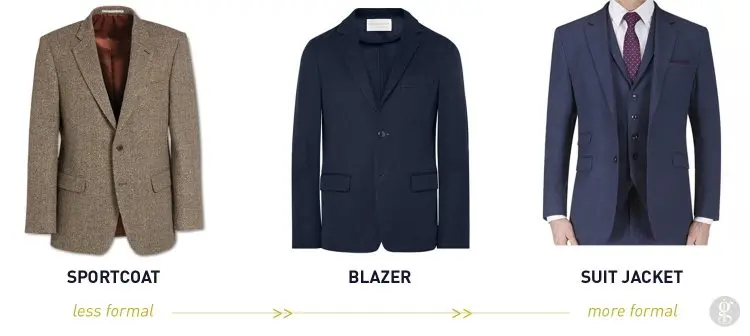
Conclusion
Understanding the differences between a sport jacket, blazer, and suit jacket may seem like a small detail, but it can completely transform the way you dress and how you’re perceived. Each jacket plays a unique role:
- The sport jacket brings relaxed sophistication and flexibility to casual wardrobes.
- The blazer offers classic style and versatility for both business and social settings.
- The suit jacket provides structure, elegance, and formality for life’s most important moments.
In a world where first impressions matter, knowing which jacket to wear is just as important as how you wear it. Fit, fabric, and confidence go hand in hand. Choose pieces that suit your personality, fit your lifestyle, and make you feel your best.
With this guide, you’re now better equipped to navigate the world of men’s tailored jackets, no more second-guessing at your wardrobe or mixing up your menswear terms.

